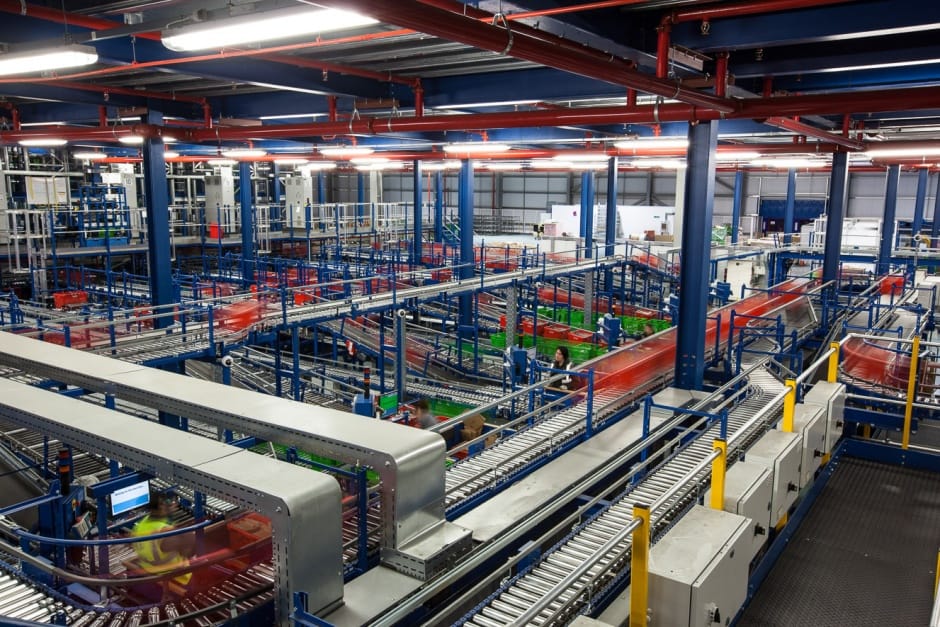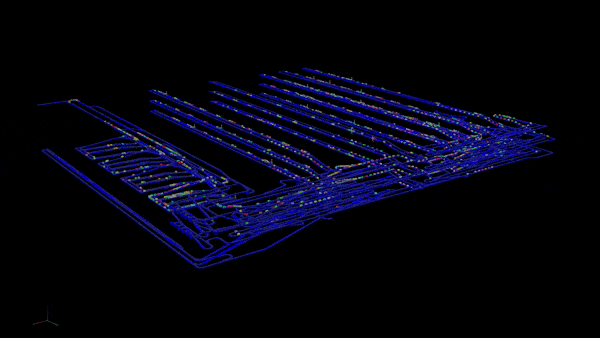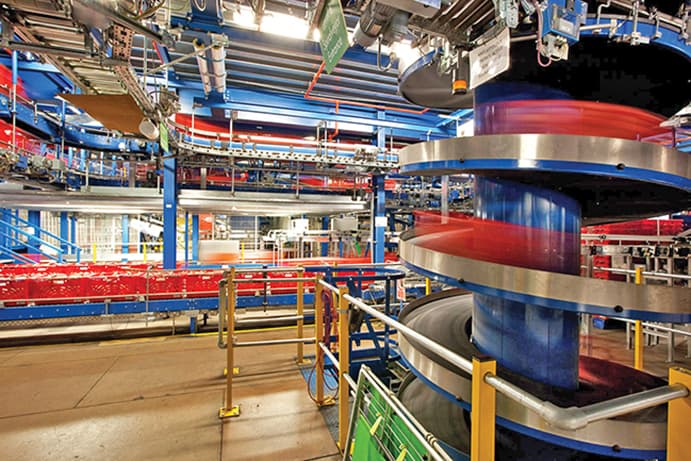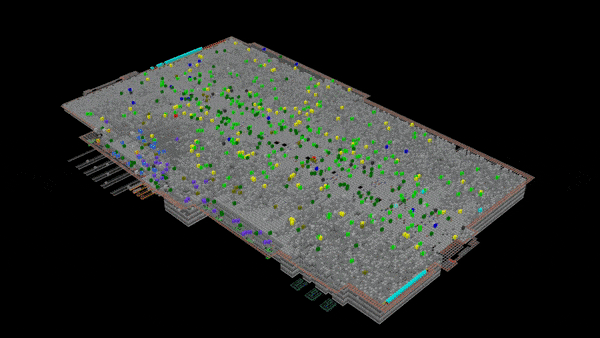If prompted to name a UK company at the cutting edge of robotics and automation, few of us would cite one of the country’s best-known grocery retailers.
But, as The Engineer learned on a recent visit to one of its key facilities, online supermarket Ocado is establishing a reputation as a major technology player: harnessing and developing machine-learning systems, Internet of Things concepts and robotic hardware to a degree that leaves many traditional engineering businesses in the shade.

Founded in 2000, the firm turned a profit for the first time in 2015 and is steadily growing its share in the UK’s enormous £179bn grocery market, processing nearly a quarter of a million shopping orders per week from its three giant customer fulfilment centres (CFCs) around England.
With most of Ocado’s big-name competitors losing money on their online operations, this success is no mean feat and is due largely to a relentless investment in technology development that enables it to process orders more rapidly and cost-efficiently than its competitors.
The firm’s original CFC – a giant automated warehouse in Hatfield (around 20 miles north of London) – provides a startling illustration of what this means in practice.

Covering five floors and crammed with an intricate 25km-long network of conveyors, the facility accounts for 40 per cent of all Ocado orders. At any time, up to 1,000 crates may be travelling along the winding routes, either ferrying products to the picking face (Ocado’s version of the supermarket aisle) or carrying shopping orders to one of its many dedicated pick stations, where human pickers are automatically guided to the correct products.
Software and AI system
The entire operation is carefully controlled by an overarching software and AI system that automatically plans the picking sequence for each shift, ensures the right products are in the right places, calculates the most efficient route for each crate and even takes account of the real-time traffic data being fed back by Ocado’s sensor-rich fleets of delivery vehicles.
According to the firm’s head of engineering R&D, Sid Shaikh, it’s a world away from other online grocery delivery operations, which typically are simple warehouses, laid out like conventional supermarkets, where human pickers trundle around the aisles collecting products as they go.
And because the approach is so different from anything else in the grocery sector, much of the underpinning technology has had to be developed in-house.
“We wanted to buy off-the-shelf components and integrate them, but nothing met our performance, cost or reliability criteria,” said Shaikh. “We tried to buy SCADA and tracking systems but nothing works to our resolution or this level of complexity. We’ve got to guarantee an end-to-end stream culminating with someone getting their shopping within a one-hour slot. It’s effectively a just-in-time system with every single order being different.”

It all makes for a climate of fast-paced innovation. And Shaikh, who joined Ocado just over two years ago after holding senior R&D roles at GSK and Cambridge Consultants, clearly relishes the opportunity to have an immediate impact on the wider business.
“When I was at GSK my job was to shorten the drug-discovery time from 10 to three years and I developed tools for research that would achieve that,” he said. “But I was very far away from seeing how my machines and systems affected the profit margin of the company because getting a drug to market takes another 10 years. I moved to Ocado because I wanted to work in production, where you can see what the impact of your efforts is.”
Shaikh estimates that the firm has a significant technical lead over its competitors – a 10-year advantage in terms of software and five years in relation to hardware – but, with online grocery retail expected to grow in the years ahead, there is no let-up in the pace of innovation.
Enter the Ocado hive
The company is in the process of rolling out a form of technology claimed to be one of the most radical innovations in retail automation yet developed. Instead of ferrying crates along a conveyor system, the new technology, dubbed Ocado Smart Platform (OSP), is underpinned by a concept whereby products are picked by armies of robots from a densely packed three-dimensional grid, or ‘hive’.

Products are stored in bins within this hive that are automatically moved to the top level of the structure when required. Teams of robots – linked wirelessly to the system via a 4G connection – scurry across the top of the hive, collecting products and ferrying them to pick stations
where the customer order is put together.
This scalable concept dispenses with the need for aisles, reduces still further the reliance on manual labour and, according to Shaikh, lowers the average pick time for a customer crate or ‘tote’ from around two hours to just 15 minutes.

Remarkably, given how futuristic it sounds, the technology is already in operation at the company’s recently opened Andover facility and it will be used at a new CFC currently under construction in Erith, south London.
According to Shaikh, as well as using it for Ocado’s own UK operations, the firm hopes to license the technology to large overseas retailers that are looking to set up their own online operations.
Given all of this automation, one wonders whether, further in the future, Ocado will still have a need for human workers. But while the firm’s technological innovations are undoubtedly rendering obsolete many unskilled roles, its investment in technology is both driving growth and creating more high-skilled jobs. In Shaikh’s team alone – which two-and-a-half years ago consisted of just himself – the firm employs 36 R&D engineers, and it has given approval for this number to grow to 60 by the end of the year.
Nonetheless, it is a big challenge to find the necessary skilled engineers to continue the sharp upward trajectory technology-wise, partly because of the industry’s wider skills gap but also, possibly, because Ocado does not immediately spring to mind as a destination for challenge-hungry engineers. Shaikh hopes this perception will change.
“We’re doing some really exciting state-of-the-art development,” he said. “We’re working with some of the biggest consultancies in the world and we’re pushing them hard to the limits. But outside companies don’t see us as that sort of place to work.”
Ocado collaborates for future robotics
Alongside internal R&D activities, Ocado is engaged in a number of external collaborative projects. One of the most eye-catching of these is the EU-funded Second Hands project, which is developing a humanoid maintenance robot designed to help engineers carry out repairs and to access areas considered too dangerous for human operators. The firm reportedly hopes to trial the robot in some of its UK facilities.

In a separate initiative – the EU-funded SoMA project – Ocado is working alongside a number of European research groups on the development of soft robotic hands specially optimised for handling easily-damageable goods, such as fruit and vegetables.
The project team has been experimenting with the use of an inflatable gripper, developed by researchers in Berlin, known as the RBO Hand 2. The gripper uses flexible rubber materials and pressurised air to passively adapt the robot’s grasp, which enables safe and damage-free picking of items.
Beyond this, according to company spokesman Alex Voica, a range of other innovations are currently under consideration, including the use of drones – rather than fixed CCTV cameras – to monitor the inside of its facilities, and the development of swarming, autonomous delivery vehicles that can be carried to a location within a larger van and then used to speed delivery to individual addresses.




Poll: Should the UK’s railways be renationalised?
I think that a network inclusive of the vehicles on it would make sense. However it remains to be seen if there is any plan for it to be for the...